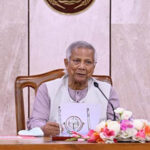Joseph Dana: Just as the supply chain crisis appeared to be stabilizing, a new set of laws in southern Africa has threatened one of the world’s most essential commodities.
Last month, Zimbabwe banned the export of raw lithium. This is a vital component of the batteries that power a wide range of consumer products, from smartphones to electric vehicles. Zimbabwe has the sixth-largest known reserves of lithium in the world and has long been an important source for the Chinese market, given close trade connections between the countries.
Will Zimbabwe’s decision usher in a new wave of resource nationalism, as other countries move to protect their own raw resources from foreign exploitation? Probably not. But the development does demonstrate how the global market for a wide range of commodities, from oil to semiconductors, is changing.
Given the establishment of new semiconductor-manufacturing plants in the US and the slow but steady de-dollarization of the international oil markets, the commodity trade is transforming quickly. Zimbabwe’s move to protect its local industry highlights how developing countries could try to protect their resources.
Lithium prices have soared by more than 1,100 percent to record highs over the past two years. The price will continue to increase as electric vehicles replace those with traditional combustion engines. Bloomberg reports that electric vehicles could account for half of all car sales by 2030, up from just 9 percent last year.
Under the new Zimbabwean laws, all exports of lithium ore (raw lithium) will require special permission and the exporter must demonstrate that it has established local manufacturing facilities. Foreign companies cannot sell ore but they can export concentrates, the powder that is created by crushing rocks and processing the ore. Exporters that do not process ore locally in Zimbabwe will be required to show that there are exceptional circumstances before they can move the raw ore out of the country.
The high price of lithium has recently attracted a slew of miners targeting abandoned mines in search of rock that might contain lithium. This rock is then exported to other countries for processing. The new laws are designed to prevent this kind of activity as well.
The rationale behind Zimbabwe’s decision reflects the new calculus arising from growing sales of electric vehicles. Instead of simply supplying the raw materials, the country wants to be part of the manufacturing process. The move is not designed to roll back centuries of colonialism; instead, the government is asking foreign powers to set up local manufacturing centers so that the country gets more of the increased revenue that is being generated by processed lithium.
Local miners have applauded this approach but the reality is that the country has a long way to go when it comes to manufacturing lithium on home soil. According to Business Insider, Australia produced about half of the world’s lithium in 2021. Chile and Argentina’s combined output accounted for 30 percent of the total, and China was responsible for about 13 percent. Zimbabwe produces just 1 percent of global output, just behind Brazil.
The track record of other countries that have attempted this approach to resource nationalism is not encouraging. Chile, home to the world’s largest-known lithium reserves, has tried and failed to enhance its lithium-manufacturing capacity over the past decade. Authorities there have not banned the export of raw lithium, nor have they fully succeeded in building up the country’s own processing power. The result has been a steady increase by the government in royalty levies on foreign producers operating in Chile.
The big question regarding Zimbabwe’s decision is how China will react to the export ban. In the past year alone, Chinese companies Zhejiang Huayou Cobalt, Sinomine Resource Group, and Chengxin Lithium Group have launched lithium projects in the country worth a combined $679 million. Under the new laws, they will be required to build new infrastructure, such as chemical conversion facilities, that can cost hundreds of millions of dollars.
Will Chinese authorities put pressure on the government, using all the Zimbabwean debt they hold as leverage to get special exemptions? If so, the entire attempt to regain control over the lithium trade will have been for nothing.
Two of the Chinese companies — Huayou Cobalt and Chengxin — have started to build processing plants in Zimbabwe that would grant them exemption from the export ban. This raises another question about Zimbabwe’s ultimate goals: If the government forces these companies to establish processing plants staffed by Chinese nationals, where is the value to the local economy? Would such a move end up generating much-needed revenue for the country? Not really.
Regardless of its viability, resource nationalism will be a central theme in 2023. As the global economy recovers from the supply chain crisis of the immediate post-pandemic period, new challenges have emerged concerning the technology and raw materials that are used to make our devices (and thus the modern world) function. These will be incredibly profound for the manufacturing of semiconductors, which is currently confined mainly to Taiwan but will soon expand in deeper ways to the US and perhaps even Europe.
As developing nations continue to struggle with the strong US dollar and the hawkish US Federal Reserve, we are bound to see more efforts to control raw materials vital to economies, such as lithium.
Last year, the global economy braced for recession as cryptocurrency and technology stocks collapsed. This year, we might see the start of a meaningful reorganization of the global commodity trade, starting with minerals such as lithium and ending with how oil is traded.
Don’t expect to see such changes overnight but the seeds of transformation have been planted. It is just a matter of time before they blossom.
Author: Joseph Dana is the former senior editor of Exponential View, a weekly newsletter about technology and its impact on society. He was also the editor-in-chief of emerge85, a lab exploring change in emerging markets and its global impact. © Syndication Bureau







